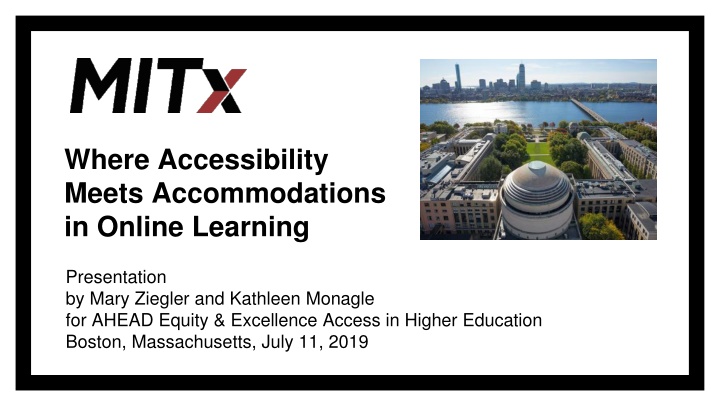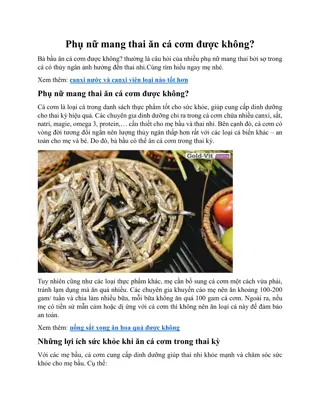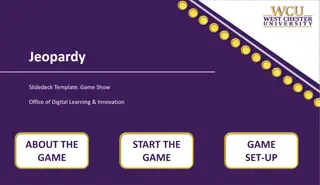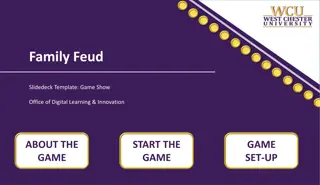
Enhancing Accessibility and Accommodations in Online Learning
Discover how MITx is innovating to make online education accessible for all learners, with a focus on creating an inclusive curriculum and accommodating individual needs. Explore the intersection of accessibility and accommodations in the context of the MITx program, showcasing evidence of learners requesting accommodations and strategies for expanding access for students with disabilities.
Download Presentation

Please find below an Image/Link to download the presentation.
The content on the website is provided AS IS for your information and personal use only. It may not be sold, licensed, or shared on other websites without obtaining consent from the author. If you encounter any issues during the download, it is possible that the publisher has removed the file from their server.
You are allowed to download the files provided on this website for personal or commercial use, subject to the condition that they are used lawfully. All files are the property of their respective owners.
The content on the website is provided AS IS for your information and personal use only. It may not be sold, licensed, or shared on other websites without obtaining consent from the author.
E N D
Presentation Transcript
Where Accessibility Meets Accommodations in Online Learning Presentation by Mary Ziegler and Kathleen Monagle for AHEAD Equity & Excellence Access in Higher Education Boston, Massachusetts, July 11, 2019
Welcome! We are pleased to join AHEAD in creating a culture that reflects Access and Inclusion, Civility and Respect Our talk today is organized into 4 sections: Context of MITx Program for accessibility at MITx Evidence of learners requesting accommodation Innovation to expand access for learners with disability 2
Context MITx Open, Online Courses 3
MITx courses are developed and taught by MIT instructors with the aim of enhancing on-campus education, expanding access to quality educational opportunities worldwide, and advancing the understanding of teaching and learning through research. Quote from https://openlearning.mit.edu/beyond-campus/mitx-edx-moocs/courses 4
176 courses, 516 course runs MIT course curriculum reflected in each 3.76 million unique learners 75% from outside of the U.S. (most countries represented) 195,499 certificates Awarded for successful completion of a course 5 MITx data as of June 18, 2019
Program MITx Online Accessibility 6
Accessible platform Foundation all MITx courses built on edX Partnership shared responsibility Opportunity connect with other educators through edX consortium of over 140 partners 7
Accessible curriculum Video captions, transcripts Images described in various ways Readings in electronic, flexible text-based formats Math accessible with MathJax or math notation Course information and contact shared with learners 8
Accommodation process Inclusive design is just part of accessibility Learners need a means to make requests Interactive process to meet accessibility requirements while upholding academic integrity 9
Evidence Where Accessibility meets Accommodations 10
Learner requests 103 requests from 54 unique learners (2016-to date) Disabilities represented 7% physical/medical, 27% vision, 66% invisible Programs 75% enrolled in MITx MicroMasters 11
Types of requests 80% of requests relate to time 20% of requests relate to use of course curriculum or content 12
Time accommodations 97% request extended testing time Timed or proctored exams Exams open 2-48 hours (expectation of time to take exam may be less) All learners have flexibility to select hours within a fixed schedule of days (3-7) 13
Content requests Content may meet WCAG accessibility guidelines yet learners experience or report access needs MITx resolves via various means (i.e. addition to course; user setting; assistive technology) 14
Content examples Chart colors indecipherable for learner with color vision deficiency Changed colors used in chart, add other visual identifiers, improve legend Math not reading to screen reader user Created usage guidelines for different screen reader/browser combinations. High contrast reversal dropped images that were transparent for low vision learner Identified browser extension/add-ons for high contrast viewing. Drag and Drop for learner with cerebral palsy Re-developed drag and drop modules to be accessible via keyboard or mouse. 15
Elements to consider Accessible platform and curriculum Communication of process Course and exam variations Rapid timelines Difference in time zone, language Efficiencies at scale 16
Innovation Open, online, accessible learning 17
Iterative process Innovations in open learning Inclusive instructional design Disability Learner research and input accommodation process 18
Questions? Mary Ziegler maryz@mit.edu Kathleen Monagle monaglek@mit.edu 19
Thanks and credits Special thanks to the people who work on and released these resources: MITx on edX Photo: Rising Behind MIT Dome with Boston Skyline in the Background, Panning to Cambridge by DronePros.net Presentation templates by SlidesCarnival 20





